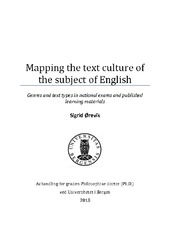| dc.description.abstract | Mapping the text culture of the subject of English investigates patterns of genres and text types in textbooks, educational websites and national exam papers for English as a common core subject in Norwegian upper secondary school. The overarching aim of the project is to unpack central aspects of the text culture of the subject and thereby provide data which may inform discussions concerning EFL materials for teaching, learning and testing. In order to describe such patterns, an empirically based typology has been developed for the project. This typology identifies individual text genres recognisable from EFL classroom practice (factual text, expository article, poem, etc.), grouping them into main categories according to predominant text type (descriptive, expository, narrative, etc.). Taking a mixed methods approach, a quantitative analysis maps and compares the distribution of genres for reception and tasks eliciting genres for production in materials for teaching, learning and testing covering the last two curriculum periods, Reform 94 (R94) and the Knowledge Promotion 2006 (LK06). The genres emerging as most frequent are subjected to a qualitative in-depth analysis. Samples of frequently occurring genres for reception are studied in terms of how these texts represent curricular topics and potentially interact with EFL students. As the empirical material comprises both print-based and digitally mediated texts, the qualitative strand of the study is divided into two sections, where the first one analyses ‘traditional’ written genres, and the second section covers digitally mediated, multimodal genres. Halliday’s theory of systemic functional linguistics (SFL) constitutes the core framework of the qualitative analysis of genres for reception, with the metafunctions of language as main analytic focus. Multimodal analysis, informed by multimodal social semiotics, complements the SFL-based study of digitally mediated, multimodal genres for reception. Samples of tasks eliciting genres for production are described in terms of elicited writing acts suggesting particular text types. Results from the quantitative strand of the study showed high frequency of descriptive genres as texts for reception in all parts of the corpus material. Genres characterised by expository writing had, in general, the highest scores among texts for production, but only moderate scores as texts for reception. Tasks eliciting argumentative genres for production had also reached a high level of frequency in national exams. The argumentative genres elicited in exams were very seldom represented among texts for reception in learning materials, however. Narrative genres for production had almost disappeared in exams after the introduction of LK06. Here textbooks differed from exam sets in including a large proportion of narrative genres both for production and reception. Findings from the qualitative strand of the study included certain variations among samples from different categories of genres for reception in their potential interaction with the reader. For example, the analysed samples of factual text and introductory text were found to take an authoritative stance towards the reader. This was slightly modified in the sample of expository article, and all but absent in the analysed sample of poem as genre for reception. Findings suggest, moreover, that digitisation and multimodality impact both representational and interpersonal aspects of EFL learning materials. This was evident, among other aspects, in differences in speech functions. Whereas textbook genres were, in general, characterised by propositions, text samples extracted from EFL websites were found to contain frequent proposals, thereby contributing to a change in interpersonal relations between students and learning materials towards a higher degree of participation. Findings from the analysis of tasks eliciting frequent genres for production indicated that the text culture of the EFL subject involved a broad range of writing acts, in keeping with the curricular aim of developing versatile writing skills in English. Results of the present study are interpreted as having a number of pedagogical implications. For example, in light of previous research-based evidence that model texts contribute to students’ tacit knowledge of genre structures, the finding that certain frequent genres elicited in writing tasks have scant representation as genres for reception in EFL materials is considered unfortunate. Qualitative results are also discussed in terms of possible factors affecting the learning potentials of texts and tasks, for example evidence suggesting that students are assigned different roles in the interaction through differences in interpersonal aspects of genre categories. Based on the findings, it can be concluded that while the range and properties of texts and tasks in published learning materials for English cover many important aspects of the subject, there are also shortcomings in the existent text culture that need to be remedied by teachers and students, as well as by materials designers. A high degree of critical awareness should therefore be integral to pedagogical practices in the EFL subject, both in terms of how genres for reception and production are selected and how they are used for teaching, learning and testing purposes. Future authors and publishers of EFL learning materials are recommended to ensure a wide and varied menu of genres for reception and production. Furthermore, suggestions are made for future revisions of the EFL subject curriculum to include in more explicit terms the skill to critically analyse texts used in the EFL classroom. It is also argued that digital skills in the EFL subject curriculum need to involve awareness of new aspects of interactivity and participation brought on by Web 2.0 media and communication. | en_US |
